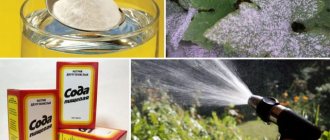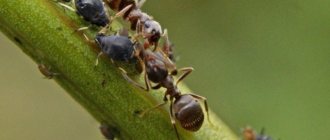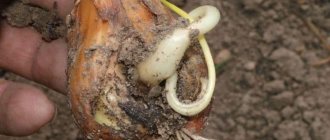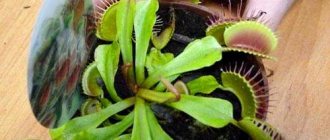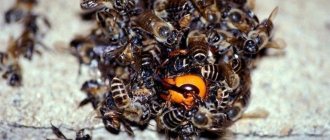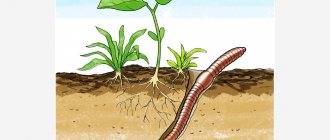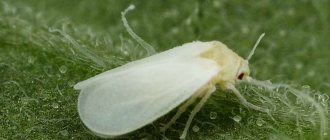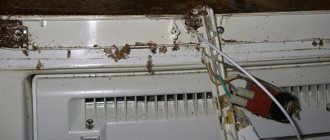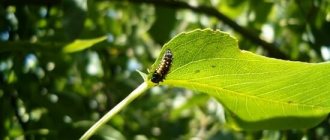The start of the fight. Season
At the very end of spring, you begin to notice occasional wasps flying by, quite large in size.
They leisurely circle around your area and, most likely, these are queens. The queen chooses a suitable place to build a nest, and rest assured, she will find it - under the roof, in building materials piled up in the yard, in old birdhouses, in cracked bark on tree trunks. Keep a close eye on the queens and try to determine where the wasp nest has appeared.
Its destruction is the main and primary action that must be carried out at the initial stage of the fight against wasps. The sooner you find the nest, the better. The more nests you find, the better. It is the physical destruction of the maximum number of individuals that will reduce the threat of crop damage in the future. To avoid having to worry about how to get rid of wasps at the end of summer, protect your vineyard in the spring.
How does defeat happen?
The largest concentration of striped insects is observed near sweet dessert grape varieties. Less sweet or sour fruits are not attractive to wasps. They also do not like berries with thick skins. This includes the following varieties:
- "Dion"
- "Mascot";
- "Adams."
These varieties differ from sweet varieties in their unusual taste characteristics, and the advantage in growing them is that they do not have to be treated with insecticides against insects. The Druzhba and Victoria varieties most often suffer from wasp attacks. The swarm of insects increases significantly as soon as the bunches begin to ripen and fill with juice. To understand how long wasps have been eating grapes is determined by their external condition:
- If the berries are damaged at points, it means that the attacks on them have just begun.
- Half of the eaten bunch indicates that insects feed on them for 20 days. Sometimes 1/3 of the bunch becomes dry.
- Most of the brushes will be empty in about a month. During this period, you can observe how the number of individuals increases several times. This means that the grapes need to be saved urgently.
Fruits that insects have not eaten will attract new insects with their aroma. As a result, about 90% of the crop will suffer. The likelihood of losing a vineyard will increase if a wasp nest is located nearby. To avoid losing most of the crop, appropriate measures must be taken immediately. What do wasps eat?
Resist the pest: general principles
When asked what to do with wasps, the answer is to fight. This is not easy: spraying with insecticides is undesirable, because The ripening of fruits and the timing of harvest do not allow for the necessary pause to mitigate the effects of toxic substances. In the event of a wasp invasion, when you urgently need to save the grapes, you can still spray them with the following composition: dilute chlorophos (50 g) in 10 liters of water.
Wasps feed on the juice of wine berries, which are often already damaged by birds
Other ways to save grapes from wasps include:
- Destruction of wasp nests. It is there that the queen, the bulk of the colony, is located. The location of the shelter is tracked in the morning when the wasps fly out or before sunset when they return. Extermination is carried out with special insecticide preparations against wasps. At nightfall, the insect-filled nest is treated with chemicals on all sides, especially in the middle. All parts of the body must be protected by protective clothing. The cuffs are firmly fixed. The head is protected by a mosquito net. A lantern with red glass is used as a light source: wasps do not perceive red waves.
- Quite often, striped insects feed on the juice of those berries that birds previously pecked - another “lovers” of eating juicy fruits. It is the sap that attracts birds. To protect bunches of grapes from wasps and birds, a special protective mesh made of fine-mesh polymer material (canvas) is used. It is installed in the path of summer, protecting the grapes. If you distribute containers of water throughout the vineyard, the birds will stop pecking at the berries, receiving life-giving moisture from the drinking bowls. This means that there will be no reason for wasps to visit the vineyard when the fruits are ripening.
Protective caps for grapes
- The most effective (most labor-intensive) is considered to be “personal” protection of bunches. To do this, special mesh bags are put on each one to protect the grapes from wasps. You can buy them in stores in different sizes depending on the weight of the brush. When making it with one’s own hands, the material used is the tulle of old curtains, gauze, even worn stockings and tights. Grono is completely isolated from insects. To do this, the bag is tied tightly at the top.
- Smoke from a fire or “Liquid Smoke” for smoking food helps to drive away insects. The low-toxic drug Sochva is used as an artificial repeller. It retains the smell of smoke, settling on the leaves and fruits.
Early destruction of the queen bee or wasp nest
The main problem when fighting these insects is that if their queen survives, then a new nest inevitably appears. As soon as it gets warm outside, the queen wakes up and looks for a place where she can create a new colony. If you destroy it during this period, then a new wasp hive will no longer appear. It is best to get rid of the uterus at a time when it has not yet woken up. In the middle zone, these insects awaken around mid-April. But it all depends on weather conditions - in a warm and early spring, the queen can wake up ahead of schedule.
These pests prefer to overwinter in places where there is protection from the cold. Under tree bark, in fallen leaves or in various nooks and crannies right in the house. Timely spraying and whitewashing of trees, collecting and burning leaves will reduce the likelihood of a wasp nest appearing on the site. A thorough cleaning of the house and outbuildings will also be beneficial. If the queen wasp still survives, you should know that before building a nest, she gains strength by feeding on the nectar of flowers on fruit trees. You can try to destroy it during this period.
If a nest does appear, then the winegrower should remember that insects do not appear at the same moment. It will be another month before the first working members of the swarm emerge. And you can save grapes from wasps by simply finding and getting rid of the nest. And it doesn’t matter if you can’t do it right away. Striped flyers begin to harm grapes only during the ripening period. Before that, they eat other insects. They are even able to protect some plants from pest invasion. But, more importantly, it is not difficult to find the nest based on the behavior of the workers. After which it will be possible to get rid of it.
Preventive measures
Experienced beekeepers know that the best way to protect a hive from any misfortune is a strong bee colony. She needs to be provided with a complete food supply and good living conditions. The family must have a young, highly productive queen. She gives more offspring. The hives should be insulated so that the bees do not have to waste energy heating the brood.
A strong family is able to cope with the invaders on its own. She can even repel an attack from hornets. The dimensions of the European hornet are 22-25 mm, they are not much larger than honey insects. In countries where aggressors reach 50-70 mm, local bees have developed special battle tactics. They surround the hornet in a dense ball of several hundred individuals. Thanks to the movement of the bodies and the vibration of the wings, the temperature inside the swarm rises to 47 0. The heat quickly kills the predator. After two or three minutes, the bees fly away and the hornet falls dead.
There are no similar posts
Ways to fight
You can fight insects in 2 ways: active and passive. When active, they destroy nests or destroy insects with pesticides. The passive method involves protecting the grapes so that wasps cannot reach them. You should not completely get rid of wasps and resort to radical methods of action, since insects play an important role in nature and help destroy parasites that feed on plants.
Mechanical structures
Mechanical methods of fighting wasps involve the use of traps, which are constructed from improvised means, mainly from a plastic bottle. Such designs are quite effective, although they look extraordinary. Making and using a trap:
- To work, you will need a plastic bottle, an attractant (a substance that attracts insects), and any sweet liquid for bait.
- The neck of 1/3 of the bottle is cut off, turned down and inserted back into the bottle.
- An attractant is added to the juice or its pulp, then the liquid is poured into a container. You can use fermented jam, compote, wine, beer or any syrup as bait.
- The prepared trap is installed in the branches of the vineyard or suspended on the vine using wire.
- Once an insect crawls into the funnel and gets inside the container, it will not be able to get back out.
Such traps need to be made and installed on the territory of the vineyard in the amount of 2-3 pieces, if you do not want to get close to the discovered nest. They are also installed for preventive purposes when no wasp nests were found during an inspection of the area.
Research scientists have noted that during the period of fruit ripening, wasps become especially dangerous, especially if there are a lot of fruits around. In the heat, their aggressiveness and viciousness increases along with their numbers. Therefore, in July and August, you need to carefully cultivate the vineyard.
Chemistry against insects
The grape harvest is saved with special insecticidal preparations and poisonous baits. Timely processing protects the berries from wasps and flies, and many other pests.
Using chemicals directly to process berries is permitted if there are more than 20 days left before harvest. Before eating, the grapes should be washed thoroughly. Poison mixed with bait, placed in the vineyard not on the berries, can be used at any time during the plant’s growing season.
Boric acid
One of the proven folk medicine is the use of boric acid. The product is sold in pharmacies in the form of a white crystalline powder. Has intestinal effects. The action begins after entering the stomach. Causes muscle paralysis and death. The proportions of boric acid from wasps should be such as not to interrupt the taste of the bait.
To prepare the solution, you need to dissolve a 10 g bag of boric acid in 1 liter of cold water. Stir until the crystals are completely dissolved. The finished product is odorless and, when combined correctly with bait, does not change the taste of food. Add 1 tbsp to each bait. a spoonful of poison solution.
As an additional ingredient, sour jam, juice, lemonade, kvass, beer, honey, and sugar syrup are used.
Insecticides
It is recommended to use odorless preparations for vineyards against wasps, so that the persistent aroma does not repel pests. The goal in this case is to kill, not drive away. If wasps have attacked grapes and continue to pester them, treat the bunches with a solution of insecticides diluted in accordance with the instructions.
The solution is prepared immediately before use. The maximum effect lasts 4 hours, the residual effect lasts from 14 to 30 days. Initially, the poison acts through contact. Insects die within 5-15 minutes from muscle paralysis. The poison is then absorbed by the tissues and kills pests as they feed.
If wasps eat grapes, the crop should be treated with modern, effective, odorless insecticidal preparations - Lambda Zone, Get, Delta Zone. Sold in concentrate form. When working with drugs, you need to use rubber gloves, a protective suit, and a respirator.
The prepared solution is also mixed into the bait, poured into a saucer, and placed in the vineyard. When using poison, you must observe safety measures for yourself and your environment. Prevent the death of beneficial insects, birds, and animals. The drugs are deadly to bees and should not be used during flowering.
Safety precautions
Wasps, especially in large numbers and in their own territory, can behave very aggressively. If you don't follow safety precautions, you could end up stung and stung multiple times. The bites cause the body and face to swell alarmingly quickly. The temperature may rise and the person may lose ability to work for some time.
It’s good if everything goes away without a trace in a few days. But allergy sufferers, of whom there are more and more people, are putting their lives in real danger. Rapidly developing anaphylactic shock is extremely serious.
Before you begin to destroy a wasp nest, make sure that you are not allergic to these insects. Usually a person knows this himself, but an allergy can appear unexpectedly. It is better to play it safe and protect yourself as much as possible from bites.
Attention! If you have a reaction to honey or redness appears to creams or preparations containing bee products, you are at risk.
What to do in this case? Entrust the removal of the wasp's nest to someone else. Or protect your body, face and eyes so that not a single wasp could get under your clothes and sting you.
It’s unlikely that you will have a complete beekeeper’s suit at home or at your dacha, so try to build it yourself.
Look for tight-fitting garments with snug fits at the wrists and ankles.
- Sweater with high collar.
- The head is tightly covered with a hood and cap.
- Protective glasses on your eyes.
- It is best to wear rubber boots on your feet.
The main idea is to cover all areas of the body with the most dense fabric possible, without a chance for an alarmed insect to fly into your wide sleeves, trouser legs or under your shirt. Even if it’s hot outside, you can endure a little in such attire.
How to behave when destroying a wasp nest:
- Avoid sudden, provoking, threatening movements. Wasps react very aggressively to this behavior, especially in defense of their offspring.
- Never kill wasps near the hive. When they die, they release a substance that will provoke the entire swarm to attack you.
- Warn your neighbors; it would be best for them to close their windows and doors for a while and not go outside.
- Think one step ahead. For example, a plan to retreat if the situation starts to get out of control.
On a note! No precautions will be superfluous. Even if you have nothing to fear and you are reliably protected, disturbed wasps from a ruined nest can attack passers-by or neighbors.
Where to put the removed nest
The discovered nest must be removed and placed in some kind of bag or tight bag. If cellophane is used, it must be durable. Torn in the turmoil, it will release the wasps outside and bring all efforts to naught.
One of the most effective ways to get rid of a wasp nest is to burn it. This is good for an open area where there is a possibility of preventing a fire if something goes wrong.
If you need to burn a removed nest in the courtyard of a residential building, then this must be done in compliance with all fire safety requirements.
Attention: Do not burn the nest right where it was found. Especially in wooden buildings, between dry boards or attic beams. A smoldering fire will start a fire some time later when you don’t expect it. Despite the obvious danger of fire, there are invariably irresponsible people who use this method.
Another option is to drown it in a large container or pond. It is used less often because it is fraught with surprises. The bag may unexpectedly tear, and the freed wasps attack the person and fly back to your house to build a new nest. Along the way, enraged, they bite everyone who gets in their way.
If you noticed the nests in the summer and did nothing or were unable to cope, then in the winter it is not difficult to remove it and burn it. Even from the most hidden places. After this, generously spray everything around with dichlorvos. In the spring, this will scare away the queen wasp and the wasps will no longer build a new house in this place. This is the easiest way.
Please note: One wasp is capable of biting more than once and when biting, it pierces the skin not only with its sting, but also with its jaws, releasing poison. Therefore, the consequences of wasp stings are more serious. Let us also take into account that wasps are different. For example, hornets are also wasps. But just the sight of them causes panic.
Video: protecting grapes from wasps and birds
Having a small vineyard, I also have to deal with wasps. I think the most effective way to protect dessert varieties is to use mesh bags. They are inexpensive and reusable. But for technical varieties this method is difficult to implement, since such grapes have a large number of small bunches growing at a fairly high altitude (up to 3.5 m). In this case, traps made from plastic bottles with bait made from old jam help me a lot. The advantage of this method for me is the fact that at the same time I protect from wasps the pear tree growing nearby, which is also susceptible to attack by these harmful insects.
Main advantages
Wasps, bees, birds are representatives of wildlife. They are only interested in their own well-being. They don't think about people's wealth. If one individual gets into the habit, you should expect the rest to appear soon. Some birds, of course, get their food alone. But insects most often act in groups.
Birds, wasps and bees eat grapes with pleasure. The leftovers from the meal, however, look unattractive. If they liked the variety, they will not calm down until they are driven away. The main thing for them is to find a stable source of food not far from the hive or nest. This guarantees the success of the species, survival, population growth, dominance.
Special bags are an ideal tool for protecting grape bunches from pests
Special bags are an ideal tool for protecting grape bunches from pests. They have many advantages compared to other methods. In particular:
- simplicity;
- availability;
- beauty;
- efficiency.
Useful tips from gardeners
To quickly eliminate wasps and protect grapes from them, you will have to familiarize yourself with the recommendations of experienced winegrowers. These include the following:
- Mechanical destruction of nests should only be done in early autumn or spring;
- when burning nests, you need to douse them with gasoline in advance;
- if traps are used to eliminate individuals in the spring, then fish is suitable for bait, since it contains a lot of protein;
- Any measures to eliminate wasps must be carried out in a special suit that the wasps cannot penetrate with their bite.
